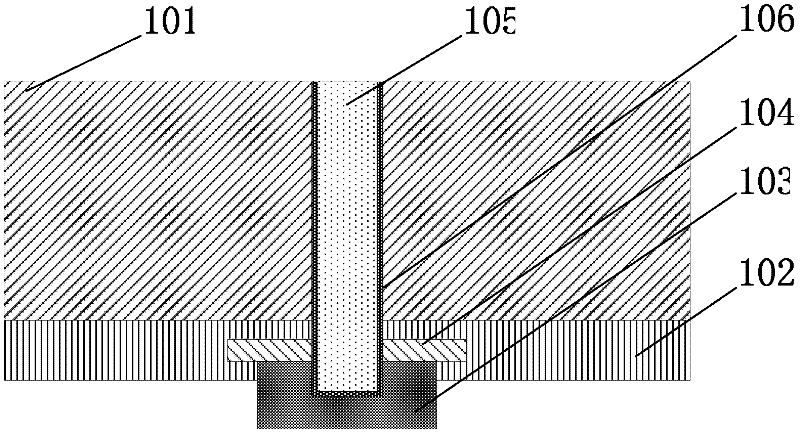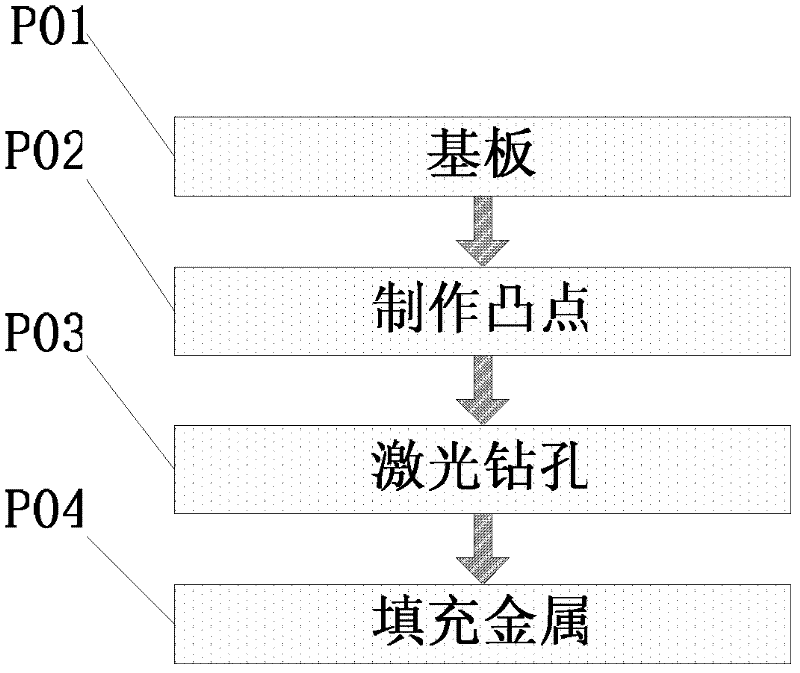Transfer plate with metal vertical interconnection structure and manufacture method thereof
A technology of vertical interconnection and manufacturing method, applied in the field of three-dimensional stacking, can solve the problems of complex process and high cost of manufacturing three-dimensional stacked chips, and achieve the effects of simplified process steps, simple structure and convenient operation.
- Summary
- Abstract
- Description
- Claims
- Application Information
AI Technical Summary
Problems solved by technology
Method used
Image
Examples
Embodiment 1
[0044] First, refer to figure 1 Embodiment 1 of the metal vertical interconnection structure applied to three-dimensional stacked chips disclosed in the present invention will be introduced. This Embodiment 1 is a specific structure when the present invention is applied to an interposer.
[0045] in such as figure 1 The shown interposer structure includes a substrate 101 . In this embodiment, the material of the substrate 101 is glass, but it may also be silicon or organic material. There is a passivation layer 102 on the lower surface of the substrate 101 . The material of the passivation layer 102 is polyimide in this embodiment. There is a metal bump structure on the lower surface side of the passivation layer 102, the metal bump structure includes a pad 104, which is buried inside the passivation layer 102, and a metal bump 103 is arranged on the lower surface of the pad 104 . In this embodiment, the pad 104 is made of metal aluminum. In this embodiment, the materia...
Embodiment 2
[0055] image 3 A metal vertical interconnection structure applied to three-dimensional stacked chips according to Embodiment 2 of the present invention is depicted. Specifically, this second embodiment is also a specific structure when the present invention is applied to an interposer.
[0056] in such as image 3 In the illustrated interposer, a substrate 206 is included. In Example 2, the substrate 206 is a 4-inch silicon wafer with a thickness of 200 microns. Optionally, the material of the substrate 206 may also be glass or organic material. On the lower surface of the substrate 206 there is a passivation layer 205 . There is a metal bump structure in the passivation layer 205 , a part of the metal bump structure is embedded in the passivation layer 205 , and another part protrudes from the lower surface of the passivation layer 205 .
[0057] Specifically, the metal bump structure includes pads 204 , underlying metal layer 203 , metal pillars 202 and solder 201 . W...
PUM
| Property | Measurement | Unit |
|---|---|---|
| Thickness | aaaaa | aaaaa |
| Thickness | aaaaa | aaaaa |
| Thickness | aaaaa | aaaaa |
Abstract
Description
Claims
Application Information
 Login to View More
Login to View More - R&D
- Intellectual Property
- Life Sciences
- Materials
- Tech Scout
- Unparalleled Data Quality
- Higher Quality Content
- 60% Fewer Hallucinations
Browse by: Latest US Patents, China's latest patents, Technical Efficacy Thesaurus, Application Domain, Technology Topic, Popular Technical Reports.
© 2025 PatSnap. All rights reserved.Legal|Privacy policy|Modern Slavery Act Transparency Statement|Sitemap|About US| Contact US: help@patsnap.com



